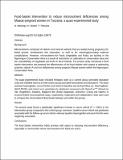| dc.description.abstract | Background
Micronutrients comprised of vitamin and mineral nutrients that are needed during pregnancy for foetal growth, development and maturation, as well as for reducing/preventing maternal complications. However, micronutrient‐rich foods (vegetables and fruits) are lacking in the Ngorongoro Conservation Area as a result of restrictions on cultivation in conservation areas and the unavailability of vegetables and fruits in local markets. The present study introduced a food basket intervention and assessed the effectiveness of the food baskets with respect to addressing anaemia, vitamin A and iron deficiencies among pregnant Maasai women within the Ngorongoro Conservation Area.
Methods
The quasi‐experimental study included Misigiyo ward as a control group (provided education only) and Olbalbal ward as an intervention group (provided food baskets and education). The study assessed haemoglobin, serum ferritin and retinol at baseline and during follow‐up. Haemoglobin, serum ferritin and retinol were quantitatively (duplicate) measured with HemoCue™ (HemoCue AB, Ängelholm, Sweden), Maglumi 800 (Snibe Diagnostic, Shenzhen, China) and vitamin A enzyme‐linked immunosorbent assay, respectively. Dependent and independent t‐tests were used to compare the micronutrient blood levels between and within the groups.
Results
The present study found a statistically significant increase in serum retinol (P < 0.001) in the intervention group compared to the control group; moreover, baseline serum retinol was positively associated with the follow‐up serum retinol, whereas baseline haemoglobin and serum ferritin were negatively associated.
Conclusions
The food basket intervention holds promise with repect to reducing micronutrient deficiency, especially in communities where micronutrient‐rich foods are scarce. | en_US |

